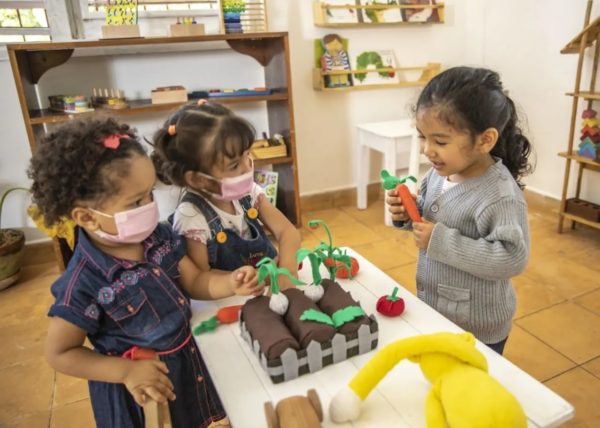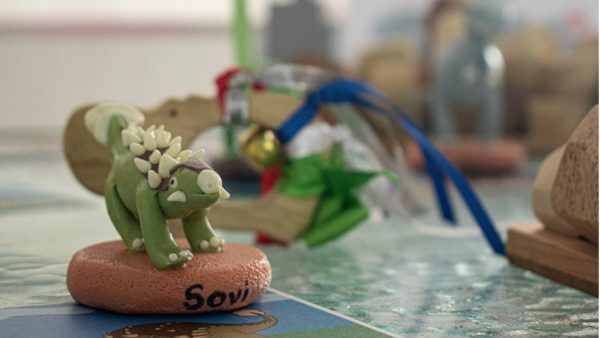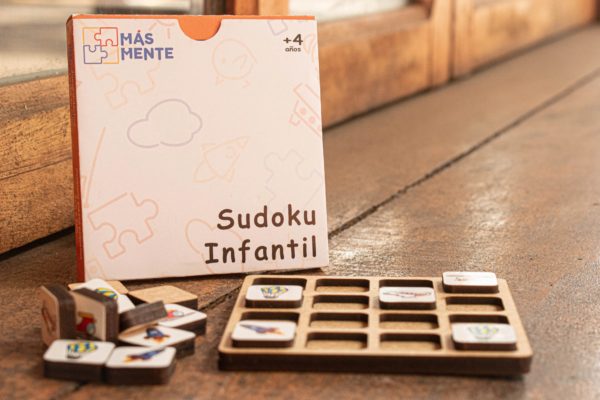Educational Toys in Cuba: a Useful and Growing Market

By Pedro Sosa Tabio (El Toque)
HAVANA TIMES – The Tragaluz project’s offices are in a big, white house, located in Havana’s Playa municipality, and it is used for many different purposes. It’s Wednesday and at 10 AM, students from Havana’s Creative Photography School arrive to have their class. From 9 AM onwards, you see some mothers sitting on the wall in the doorway or hanging outside a window, watching what their barely 1-year-old children are up to inside.
On the other side of the window, there’s a room with shelves full of toys. Some are wooden, others are made of plastic, felt, fabric, crochet…
Ana Mae Inda created this space, which is called the Ludoteca. However, when she invites somebody to come in, she doesn’t talk about a game room, but a workshop. You’d think you’d find children a little older sitting at small desks, having a class, but you get there and find a handful of babies that can just about say mama, but already know how to play.
That’s the key here. A little girl moves a wooden, round cell, which she can use to practice grabbing with her entire hand and “make a crab claw” – holding something with a couple of stretched-out fingers – at the same time, by putting her fingers between the bars, which helps children this age to develop their motor skills.
Another small child takes out small squares and circles that are joined together to a wooden base with longer pieces sticking out of it. Then, he puts them back and is able to improve his clasp – trying hard to get the long stick back in through the hole in the middle -, and he will slowly learn association when he begins to join squares with other squares and circles with circles.
Thus, the Ludoteca turns playtime into a space for development and toys into the tools that make this possible, which they were designed and made for.
Some toys were made by Mae herself for her business El Mundo de Amalia, but the Ludoteca has toys from at least another ten Cuban businesses that make educational toys. They aren’t all of the them, though. As toys from other projects have emerged, especially during the pandemic in Cuba. “Artisan” is the license that covers them, which is granted to people who “make, produce, repair and sell handmade articles, accessories and clothes (…) transforming non-precious materials.

Lockdown and delays in child development
Yarelys Herrera is a microbiologist, but a few years ago, while studying her masters in Russia, she taught Spanish to children older than one and had to learn the educational methods used at the school where she was teaching.
Then, she had her own daughter when she came back to Cuba and had to adapt what she had learned and read new books and articles about learning and education.
During 2020, in the middle of the lockdown, many groups appeared on social media due to users’ common wants or needs to deal with the lack of social interaction that came with forced quarantine.
Yarelys was the admin of one of these groups. She called it Bebe Capaz and shared activities in this group that stimulate child development with other parents, things that could be done at home.
Then, she thought about making some toys for her little girl and had help from Daniel Hernandez, her husband, who is a mathematician, but enjoys the crafts and manual work.
They weren’t any old toys. She remembers that the first toys were puzzles and a moon balance, which are meant for children to take off and put pieces back on a semicircular base to keep the scale balanced. That is to say, they were toys conceived to develop different skills for her daughter.
As soon as she shared them in the Bebe Capaz group, other parents fell in love with them and wanted them for their children too. That’s how Sovi Juguetes was born, run by Yarelys and Daniel.
“Children had lots of problems with COVID-19, not just in Cuba, but worldwide,” Ana Mae explains, “especially because they suffered delays in speech because they were unable to socialize. Many mothers wrote to me during that time asking for advice. So many mothers, you can’t imagine.”
Mae has two children: a 7-year-old called Mauricio and Amalia, who is now 9 years old, who was born without a part of the fourth chromosome, which happens to one in every 50,000 people and normally results in delays in development, intellectual handicaps and facial deformities, as well as other symptoms. Mae began to study education and brain development, ever since she was born so she could help her. That’s how she managed to get her to walk, even though the experts had said that her lack of genetic information would mean that she could never walk.
She also led a project at the Creative Photography School before the pandemic, called Arte para Emocionar, which worked with children at her son’s school to teach them emotional intelligence, which is Mae’s passion and which she is studying an international masters in today.
During the lockdown, she discovered many businesses dedicated to toymaking while helping parents individually or via groups on social media. Sovi was one of them and she saw that it was a growing field that she knew about and had been dabbling with ever since she began to make toys for her daughter. That’s how El Mundo de Amalia was born.

Every benefit is for children
“The main reason I opted for these products was that there weren’t a lot of options to buy toys for babies. Especially because they tend to be very expensive. You can’t buy them at national currency stores and they are quite expensive at MLC (freely convertible currency) stores,” Danae Ricardo says, the mother of a five-month-old baby who has bought many toys from Cuban businesses.
Even though shortages were her main reason, she doesn’t regret buying them. “I bought a teether, some rings to hold with your hands and a rattle, and all three of them have been very useful. I’ve noticed that ever since she’s had these toys, her hands have got stronger and she has a stronger grip,” she says.
Cuba has been suffering a shortages crisis ever since late 2018, which reached its peak during the pandemic. Going hand-in-hand with the Currency Reform which was implemented in January 2021, this has led to shortages and inflation in practically every market sector, and toys haven’t been the exception.
“It’s pretty much impossible to buy toys at stores. They are bought as soon as they come in, so they can be resold at exorbitant prices,” Daniel Hernandez from Sovi Juguetes explains. “Plus, they’re made out of plastic. If a child drops them, they break. The toys that many of us self-employed toymakers make are normally wooden or made out of other resistant, high-quality materials and that provide a solution to current market demand. We are not only giving a toy to a child for them to have fun, but we are also giving them a tool so they can develop.”
Mae believes that there are plenty of toys that can be bought, despite shortages in stores. Susana Nunez, a psychologist and researcher at the Cuban Neuroscience Center, agrees. She is the mother of a small boy and has been running another educational toymaking business with her husband Pedro Diaz and her friend Danay Mila: Más Mente.
Susana contemplates the added value of toys beyond just quantity and variety. “The advantage of all of this is that it has sparked a movement that invites people to educate through play,” she says. “It moves children away from screens, that can cause behavior similar to autism, and allows healthy early development. All of the benefits are for the kids.”
She adds that “of course, it has to be said that this means more work for parents, because the child needs the adult to guide them and they can’t free themselves half a day by having their children watching cartoons. But, children need adults to guide them! In any case, this is how it works. Children develop with an adult’s mediation. Adults teach the world to children. That’s just the way it is.”
Maria Isabel Fernandez, who bought her little girl a pack of cards with characters to encourage her to make up stories, is a clear example of this. “My daughter understood when people talked and said words, but at four years of age, she still wasn’t making full sentences. By playing a lot with her and these cards, making up stories, getting her to contribute and say what happens to the characters or what they have to do, has broadened her vocabulary and she strings along sentences. She’s improved a lot. She has a ways to go, but you can see her progress.”
Ernesto Rubio says that several toys conceived to associate figures by their color or their shape, which were also bought from Cuban businesses, helped his five-year-old son to learn colors and geometrical shapes. “My son was already five years old and his education depended on us at home. We didn’t know when the pandemic would allow him to go back to school again, so we decided to take action and the toys really helped. As it was something he could see and handle, it was easier for him to learn,” he explains.
In order to make sure that her toys are used properly and are effective, Susana sells them with a lengthy guide explaining what age group they are for and everything that you can do with them. Before selling them, she goes to great lengths to learn about the child they are destined for and guides parents to choose the best toy.
The other businesses have similar protocol. They also are constantly teaching on social media and organizing or joining free workshops for parents and children, such as the case of the Ludoteca, to encourage responsible raising and child development.
According to Mae, “this is more than just selling toys. It’s making sure they are being used properly, running workshops, teaching… and it’s more for the parents than for children.”

Production
In addition to her connection with the Creative Photography School and her work at El Mundo de Amalia, Mae runs a project called Habana es Nombre de Mujer, that bring together Cuban businesswomen and shines a spotlight on their work. She has met many of the women selling educational toys via this project, and so she has a varied collection in her Ludoteca.
At a quick glance, you can see that the materials of toys vary according to the specialty of each business: some are made out of crochet, but the majority are wooden, a resistant, non-toxic material, that is easier to get a hold of and work within Cuba, than other materials such as plastic or rubber…
“It’s a fluctuating market that limits us all,” Yarelys says. “You can’t keep prices of a toy stable for months on end, because the dollar exchange rate suddenly goes up and so does everything else, as a result. Nor is there a set place where you can go to buy raw materials.”
However, in Sovi Juguetes’ catalog, you can find toys that cost between just over 100 pesos and up to 500, depending on their difficulty level. Even so, they are still a lot cheaper than any toys resold on the illicit market.
Navigating shortages of supplies, they always work with recycled wood whenever they can. They even make the most of trees that the Electric Company sometimes cuts down and leave on the street.
But they don’t use any old material for teethers and other toys that children normally put in their mouths, buying better quality cuts of wood from some carpenters.
Other businesses, such as Mas Mente, create and design their own pieces, but outsource wood cutting and other physical jobs such as printing, to other workshops. Even though materials isn’t a direct concern for them, it’s not all smooth sailing either.
“Last December, we had to get everything ready for the end of the year and Christmas, and when we went to the printer, they told us that they had to throw out their toners. The ship bringing in the ink was late, and we had to wait for it to arrive. It finally arrived in February, so January was a whole month without production,” Pedro Diaz from Mas Mente says.
Despite problems with raw materials and irregular production, they still run these businesses specializing in educational toys.
For example, at El Mundo de Amalia, Mae makes a new toy every 15 days, although there are small batches and for different age groups.
If these companies had better access to materials, they could drop their prices – or at least stop them from growing -, and flood the Cuban market with quality toys, mostly designed by mothers and fathers that want to help other parents and spread a philosophy of raising children where the objective is always better child development.






